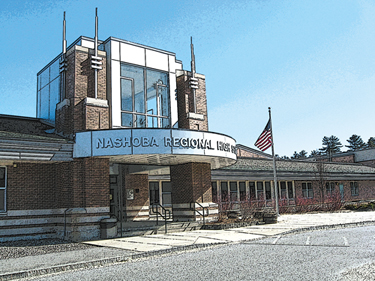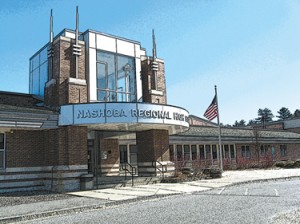
By Ann Needle 
The Nashoba Regional High School Space Task Force offered a glimpse on Wednesday of what NRHS may need to address to help keep its accreditation.
At Wednesday’s meeting of the group charged with recommending how to address the space crunch at NRHS, the Task Force reviewed some of the space- and facilities-related findings noted by the New England Association of Schools and Colleges. Earlier this month, NEASC issued its findings on the high school from last spring’s re-accreditation process. Its assessment covered key areas from curriculum to supporting facilities. Formal ratings for each category—and the high school’s re-accreditation status—will be released some time this fall.
The Task Force’s Bob Czekanski put together a list of NEASC’s comments on facilities. The positive news Czekanski highlighted from the report was that NEASC found, “The NRHS facility is adequate and is sufficiently maintained in order to support the delivery of school programs and services.” But, NEASC tempered this statement with, “However, the facility requires updating in order to meet the needs of [a] 21st century curriculum.” Among NEASC’s related observations was that the Science labs need to be updated, something already acknowledged by Nashoba.
NEASC also called out other conditions the district has discussed, including crowded locker situation, with lockers sometimes lining both sides of a corridor and making it tough to travel through. And, while NEASC reported that the staff commented on the cafeteria’s shortage of seating, it remarked that students themselves did not point the situation out as a “major issue.”
The one area NEASC called out that Czekanski said the Task Force has not addressed was lack of privacy in the Health Services office. Though NEASC did not offer much detail on what it found, Czekanski explained that Superintendent Michael Wood agreed it was “definitely a space issue.” Czekanski reported that Wood mentioned part of the issue might be that only a curtain separates the examining room from the waiting area. (The Task Force’s Maureen Busch of Stow remarked that she was surprised this has not come up as an issue under HIPAA law.)
Among the NEASC recommendations Czekanski noted from the report were developing plans for assuring Nashoba’s physical plant supports effective instructional practices, addressing staff needs and changing enrollments, and identifying facilities needed to assure effective teaching and learning.
A Modular Hit
Nashoba Director of Facilities Bill Cleary had an upbeat report on some temporary relief to crowding at the high school. Cleary told the Task Force that the two modular classrooms donated to NRHS by Stow from the former Pompositicutt School were “installed and open on day one.” Despite earlier concerns, the fire alarm system was fully integrated on opening day, along with the wireless network, Cleary said.
Because students must leave the main building to enter the portable classrooms, Cleary explained that the district installed a wooden fence for security around the modulars, along with security cameras. So far, the moving and installation cost is coming in on budget (about $85,000), Clear said. He added, “It’s a very, very comfortable classroom[s].”
In another space shortage issue at NRHS, Cleary said the new system of assigning student parking spaces seems to be working well. With students often out of luck snagging a parking space in the past, even after purchasing their passes, this year the school numbered the 215 spaces and assigned each pass-holder a numbered space. Despite student complaints abut the new system, Cleary said he has seen a marked drop in complaints from students getting locked out of parking.
In ongoing business, Bob Czekanski estimated the Task Force should have a new bidding request out for a demographic study of the district towns in about 2 weeks. The original request brought in only two bidders, each well over the estimated $10,000 – $15,000 the Task Force noted it was hoping to spend. The study is aimed at helping chart potential changes in the Nashoba student population over the next 10 to 15 years.